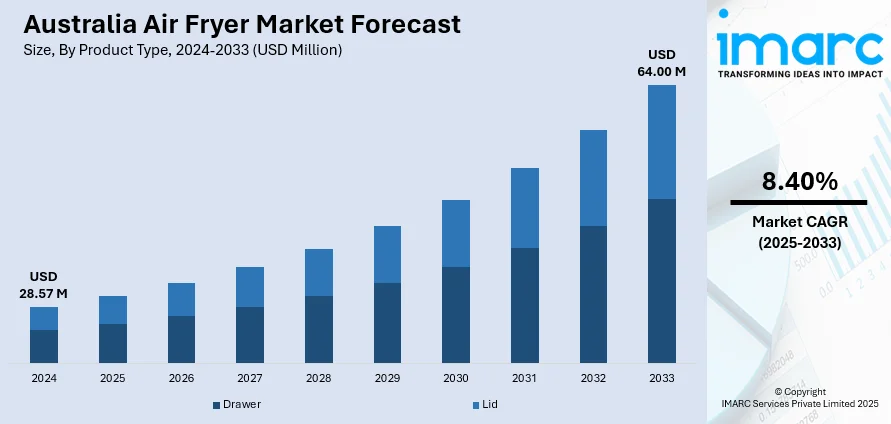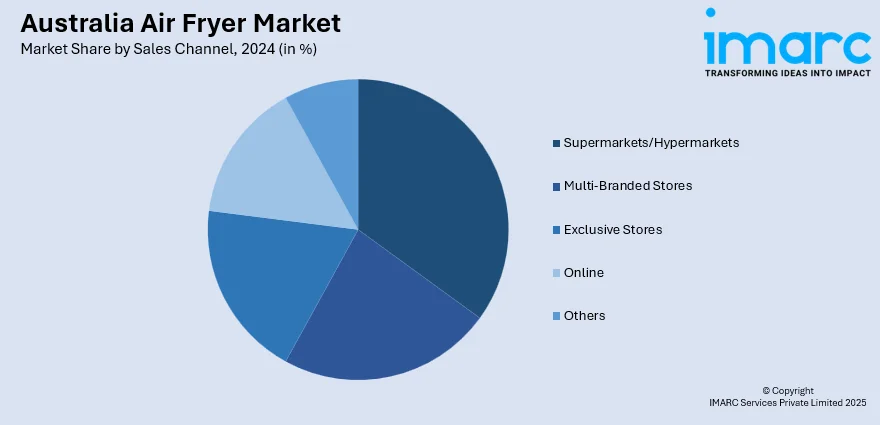
Australia Air Fryer Market Size, Share, Trends and Forecast by Product Type, Technology, Sales Channel, End Use, and Region, 2025-2033
Australia Air Fryer Market Size Overview:
The Australia air fryer market size reached USD 28.57 Million in 2024. Looking forward, the market is expected to reach USD 64.00 Million by 2033, exhibiting a growth rate (CAGR) of 8.40% during 2025-2033. The market is witnessing steady growth, driven by health-conscious consumers who are resorting to air fryers since they provide a healthier option compared to conventional deep-frying techniques at a very low use of oil. The timesaving and convenience-based advantage of air fryers, enabling rapid meal preparation without sacrificing flavor, along with the advances in technology, have also resulted in the creation of intelligent air fryers with functionalities such as digital controls and connectivity through apps, which further increases the Australia air fryer market share.
|
Report Attribute
|
Key Statistics
|
|---|---|
|
Base Year
|
2024 |
|
Forecast Years
|
2025-2033
|
|
Historical Years
|
2019-2024
|
| Market Size in 2024 | USD 28.57 Million |
| Market Forecast in 2033 | USD 64.00 Million |
| Market Growth Rate 2025-2033 | 8.40% |
Key Trends of Australia Air Fryer Market:
Health-Focused Cooking Fuels Demand
Australia’s increasing focus on healthier diets is profoundly impacting kitchen appliance demand, along with the greater appeal of air fryers. The appliances enable consumers to cook meals using very little oil, which is in concert with the rising demand for low-fat preparation methods. The capability of producing crispy results without deep frying complements dietary objectives with a view to lowering calories. This trend is evident in several Australian homes, where air fryers are becoming a standard for people looking for healthier meals. The ease of use of air fryers, coupled with their health advantages, makes them a desirable option for health-conscious consumers nationwide, which further propels the Australia air fryer market growth.

To get more information on this market, Request Sample
Technological Innovations Improving User Experience
The incorporation of cutting-edge technologies into air fryers is revolutionizing the cooking experience for Australian consumers. Today's air fryers come with digital controls, pre-programmed cooking functions, and enhanced safety features, which make them more convenient and effective. Some models also have smart features, which enable users to remotely control the device through mobile apps. Such features appeal to tech-conscious Australian consumers, where convenience and usability are greatly desired. Ongoing innovation in air fryer technology means that such appliances are aligned with the changing needs and wants of Australian consumers, further stimulating their use across homes throughout the country.
Space-Saving Models Suit Urban Homes
In urban Australia, where kitchen space is at a premium, the small and space-saving models of newer air fryers are especially suited. Manufacturers are answering this call by producing slim, compact models that fit perfectly into smaller kitchens without sacrificing performance. These space-saving designs make air fryers the perfect option for apartment dwellers and those with limited counter space. The perfect blend of functionality and miniaturization means that Australian consumers can access the convenience of air frying without needing to have large kitchen space, with these appliances proving to be a convenient addition to city homes.
Growth Drivers of Australia Air Fryer Market:
Rising Popularity of Quick and Convenient Cooking
One of the key growth drivers of the Australia air fryer market is the increasing demand for fast and hassle-free cooking solutions. With busy work schedules and evolving lifestyle patterns, consumers are looking for appliances that save time in meal preparation without compromising on taste. Air fryers cater perfectly to this need by significantly reducing cooking times compared to traditional ovens or stovetops. Their ability to prepare a wide range of dishes, from snacks to full meals, makes them highly versatile, appealing to both singles and families. As convenience becomes a central factor in purchase decisions, air fryers are gaining popularity across Australian households, driving consistent growth in the Australia air fryer market demand.
.Expanding Awareness Through Marketing and Branding
Strong marketing strategies and brand promotions are significantly boosting the adoption of air fryers in Australia. Leading kitchen appliance brands and retailers are actively highlighting the benefits of air fryers through digital campaigns, in-store demonstrations, and collaborations with food influencers. This visibility helps educate consumers about healthier cooking techniques, recipe possibilities, and energy efficiency advantages. Partnerships with food platforms and recipe websites further enhance consumer engagement, making air fryers more relatable and desirable for everyday use. Such promotional activities not only create brand loyalty but also encourage first-time buyers to invest in air fryers. The result is rising awareness, expanding customer reach, and sustained growth in the Australian market.
Shifting Consumer Preferences Toward Sustainable Living
Growing environmental consciousness is influencing consumer preferences in the Australian home appliance sector, and air fryers align well with this trend. According to the Australia air fryer market analysis, these devices typically consume less energy than conventional ovens, contributing to lower household power usage and reduced carbon footprints. Moreover, by encouraging oil-free or low-oil cooking, they support sustainable dietary practices linked to health and wellness. Younger consumers are drawn to appliances that combine eco-friendliness with efficiency. As Australians increasingly prioritize sustainability in their purchasing decisions, air fryers are emerging as a favored choice in modern kitchens. This shift toward greener living and smarter consumption patterns continues to propel market growth nationwide.
Australia Air Fryer Market Segmentation:
IMARC Group provides an analysis of the key trends in each segment of the market, along with forecasts at the country and regional levels for 2025-2033. Our report has categorized the market based on product type, technology, sales channel, and end use.
Product Type Insights:
- Drawer
- Lid
The report has provided a detailed breakup and analysis of the market based on the product type. This includes drawer and lid.
Technology Insights:
- Digital
- Manual
A detailed breakup and analysis of the market based on technology has also been provided in the report. This includes digital and manual.
Sales Channel Insights:

- Supermarkets/Hypermarkets
- Multi-Branded Stores
- Exclusive Stores
- Online
- Others
A detailed breakup and analysis of the market based on the sales channel has also been provided in the report. This includes supermarkets/hypermarkets, multi-branded stores, exclusive stores, online, and others.
End Use Insights:
- Residential
- Commercial
The report has provided a detailed breakup and analysis of the market based on the end use. This includes residential and commercial.
Regional Insights:
- Australia Capital Territory & New South Wales
- Victoria & Tasmania
- Queensland
- Northern Territory & Southern Australia
- Western Australia
The report has also provided a comprehensive analysis of all the major regional markets, which include Australia Capital Territory & New South Wales, Victoria & Tasmania, Queensland, Northern Territory & Southern Australia, and Western Australia.
Competitive Landscape:
The market research report has also provided a comprehensive analysis of the competitive landscape. Competitive analysis such as market structure, key player positioning, top winning strategies, competitive dashboard, and company evaluation quadrant has been covered in the report. Also, detailed profiles of all major companies have been provided.
Australia Air Fryer Market News:
- In April 2025, Australian creative agency Common Ventures launched a North American campaign for Breville, highlighting the ease and practicality of its latest air fryer. The initiative emphasizes the product’s user-friendly design while showcasing Breville’s focus on simplifying modern cooking experiences.
- In May 2025, a first-of-its-kind product was introduced by the Sydney-based company, Workout Meals. The company debuted a line of ready-made meals specifically formulated for air fryers. This revolutionary new range features 12 high-protein, low-fat selections, all packaged in environmentally friendly materials. Tapping into the immense popularity of air fryers in Australia, these meals are designed for quick and easy preparation, cooking in under 15 minutes, and catering to a growing demand for convenient, health-conscious options.
- In February 2025, Panasonic unveiled its premium 34-litre 4-in-1 Air Fry Convection Microwave Oven, the NN-CD88, in the Australian market. This singular appliance consolidates four key cooking functions—microwave, oven, grill, and air fryer—to deliver unparalleled versatility. With advanced inverter heating technology and integrated moisture sensors, the NN-CD88 is engineered for precise cooking. Its introduction addresses the consumer trend favoring multifunctional appliances that support a health-oriented lifestyle.
- In October 2023, Taste.com.au named Tefal, a trusted cookware brand with over six decades of expertise, as the inaugural partner of its Taste Test Kitchen. Introduced earlier this year, the platform serves as a hub where consumers can explore, purchase, and learn to use kitchen appliances, tools, and products.
Australia Air Fryer Market Report Coverage:
| Report Features | Details |
|---|---|
| Base Year of the Analysis | 2024 |
| Historical Period | 2019-2024 |
| Forecast Period | 2025-2033 |
| Units | Million USD |
| Scope of the Report |
Exploration of Historical Trends and Market Outlook, Industry Catalysts and Challenges, Segment-Wise Historical and Future Market Assessment:
|
| Product Types Covered | Drawer, Lid |
| Technologies Covered | Digital, Manual |
| Sales Channels Covered | Supermarkets/Hypermarkets, Multi-Branded Stores, Exclusive Stores, Online, Others |
| End Uses Covered | Residential, Commercial |
| Regions Covered | Australia Capital Territory & New South Wales, Victoria & Tasmania, Queensland, Northern Territory & Southern Australia, Western Australia |
| Customization Scope | 10% Free Customization |
| Post-Sale Analyst Support | 10-12 Weeks |
| Delivery Format | PDF and Excel through Email (We can also provide the editable version of the report in PPT/Word format on special request) |
Key Benefits for Stakeholders:
- IMARC’s industry report offers a comprehensive quantitative analysis of various market segments, historical and current market trends, market forecasts, and dynamics of the Australia air fryer market from 2019-2033.
- The research report provides the latest information on the market drivers, challenges, and opportunities in the Australia air fryer market.
- Porter's five forces analysis assist stakeholders in assessing the impact of new entrants, competitive rivalry, supplier power, buyer power, and the threat of substitution. It helps stakeholders to analyze the level of competition within the Australia air fryer industry and its attractiveness.
- Competitive landscape allows stakeholders to understand their competitive environment and provides an insight into the current positions of key players in the market.
Key Questions Answered in This Report
The air fryer market in Australia was valued at USD 28.57 Million in 2024.
The Australia air fryer market is projected to exhibit a CAGR of 8.40% during 2025-2033.
The Australia air fryer market is projected to reach a value of USD 64.00 Million by 2033.
The Australia air fryer market is witnessing growth driven by rising health consciousness and preference for oil-free meals. Technological innovations like smart connectivity and multi-functional designs are further shaping consumer adoption, making air fryers a popular kitchen appliance choice.
The growth of Australia’s air fryer market is fueled by increasing demand for low-oil cooking alternatives, and rising adoption of smart kitchen appliances. Busy lifestyles, urban household expansion, and the preference for quick, convenient, and energy-efficient cooking methods are further accelerating market demand.
Need more help?
- Speak to our experienced analysts for insights on the current market scenarios.
- Include additional segments and countries to customize the report as per your requirement.
- Gain an unparalleled competitive advantage in your domain by understanding how to utilize the report and positively impacting your operations and revenue.
- For further assistance, please connect with our analysts.
 Request Customization
Request Customization
 Speak to an Analyst
Speak to an Analyst
 Request Brochure
Request Brochure
 Inquire Before Buying
Inquire Before Buying




.webp)




.webp)












